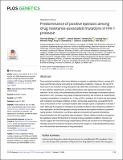Predominance of positive epistasis among drug resistance-associated mutations in HIV-1 protease
Author(s)
Zhang, Tian-hao; Dai, Lei; Barton, John P; Du, Yushen; Tan, Yuxiang; Pang, Wenwen; Chakraborty, Arup K; Lloyd-Smith, James O; Sun, Ren; ... Show more Show less
DownloadPublished version (2.019Mb)
Publisher with Creative Commons License
Publisher with Creative Commons License
Creative Commons Attribution
Terms of use
Metadata
Show full item recordAbstract
Copyright: © 2020 Zhang et al. This is an open access article distributed under the terms of the Creative Commons Attribution License, which permits unrestricted use, distribution, and reproduction in any medium, provided the original author and source are credited. Drug-resistant mutations often have deleterious impacts on replication fitness, posing a fitness cost that can only be overcome by compensatory mutations. However, the role of fitness cost in the evolution of drug resistance has often been overlooked in clinical studies or in vitro selection experiments, as these observations only capture the outcome of drug selection. In this study, we systematically profile the fitness landscape of resistance-associated sites in HIV-1 protease using deep mutational scanning. We construct a mutant library covering combinations of mutations at 11 sites in HIV-1 protease, all of which are associated with resistance to protease inhibitors in clinic. Using deep sequencing, we quantify the fitness of thousands of HIV-1 protease mutants after multiple cycles of replication in human T cells. Although the majority of resistance-associated mutations have deleterious effects on viral replication, we find that epistasis among resistance-associated mutations is predominantly positive. Furthermore, our fitness data are consistent with genetic interactions inferred directly from HIV sequence data of patients. Fitness valleys formed by strong positive epistasis reduce the likelihood of reversal of drug resistance mutations. Overall, our results support the view that strong compensatory effects are involved in the emergence of clinically observed resistance mutations and provide insights to understanding fitness barriers in the evolution and reversion of drug resistance.
Date issued
2020Department
Massachusetts Institute of Technology. Institute for Medical Engineering & Science; Massachusetts Institute of Technology. Department of Chemical Engineering; Massachusetts Institute of Technology. Department of Physics; Massachusetts Institute of Technology. Department of Chemistry; Ragon Institute of MGH, MIT and HarvardJournal
PLoS Genetics
Publisher
Public Library of Science (PLoS)